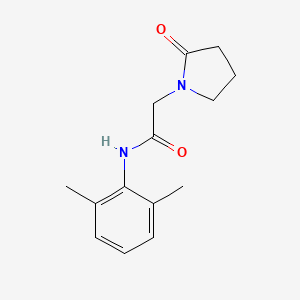



1. Dm 9384
2. Dm-9384
3. N-(2,6-dimethylphenyl)-2-(2-oxo-1-pyrrolidinyl)acetamide
1. 77191-36-7
2. N-(2,6-dimethylphenyl)-2-(2-oxopyrrolidin-1-yl)acetamide
3. Translon
4. Dm 9384
5. Nefiracetam [inn]
6. Motiva
7. Dzl-221
8. N-(2,6-dimethylphenyl)-2-oxo-1-pyrrolidineacetamide
9. 1-pyrrolidineacetamide, N-(2,6-dimethylphenyl)-2-oxo-
10. Nefiracetam (translon)
11. Nsc-759830
12. 2-oxo-1-pyrrolidineaceto-2',6'-xylidide
13. 1jk12gx30n
14. Dm9384;dzl-221
15. Ncgc00186006-01
16. N-(2,6-dimethylphenyl)-2-(2-oxo-1-pyrrolidinyl)acetamide
17. Cas#77191-36-7
18. Dsstox_cid_923
19. Dsstox_rid_75870
20. Dsstox_gsid_20923
21. Dmppa
22. Nefiracetamum
23. Dm-9384
24. Nefiracetamum [inn-latin]
25. Smr001456240
26. Cas-77191-36-7
27. Ccris 6729
28. Brn 6848330
29. N-(2,6-dimethylphenyl)-2-(2-oxo-1-pyrrolidinyl]acetamide
30. Unii-1jk12gx30n
31. Nefiracetam, Solid
32. Mfcd00209882
33. Nefiracetam [mi]
34. Nefiracetam [jan]
35. Nefiracetam [mart.]
36. Mls004774126
37. Mls006010195
38. Schembl135856
39. Chembl260829
40. Zinc3788
41. Dtxsid2020923
42. Dzl 221
43. Chebi:135004
44. Hms3261i16
45. Hms3655n05
46. Hms3884c18
47. Pharmakon1600-01502315
48. Bcp21371
49. Cda19136
50. Hy-b0340
51. Tox21_113521
52. Tox21_201916
53. Tox21_303025
54. Tox21_500447
55. Dm9384
56. Nsc759830
57. S1969
58. Akos015895083
59. Tox21_113521_1
60. Ab04796
61. Ccg-213818
62. Db13082
63. Ks-5226
64. Lp00447
65. Nsc 759830
66. Sdccgsbi-0633714.p001
67. Ncgc00186006-02
68. Ncgc00186006-03
69. Ncgc00186006-04
70. Ncgc00186006-11
71. Ncgc00256487-01
72. Ncgc00259465-01
73. Ncgc00261132-01
74. Ac-15655
75. Ac-32883
76. Db-056185
77. Ft-0630853
78. N0996
79. Sw219212-1
80. T72927
81. Ab01274721-01
82. Ab01274721_02
83. Ab01274721_03
84. 191n367
85. A838998
86. Sr-01000883754
87. Q6039388
88. Sr-01000883754-1
89. 1-pyrrolidineacetamide,n-(2,6-dimethylphenyl)-2-oxo-
90. Z79686019
91. Dm-9384; Dzl-221; Dm9384; Dzl221; Dm 9384; Dzl 221
| Molecular Weight | 246.30 g/mol |
|---|---|
| Molecular Formula | C14H18N2O2 |
| XLogP3 | 1.4 |
| Hydrogen Bond Donor Count | 1 |
| Hydrogen Bond Acceptor Count | 2 |
| Rotatable Bond Count | 3 |
| Exact Mass | 246.136827821 g/mol |
| Monoisotopic Mass | 246.136827821 g/mol |
| Topological Polar Surface Area | 49.4 Ų |
| Heavy Atom Count | 18 |
| Formal Charge | 0 |
| Complexity | 320 |
| Isotope Atom Count | 0 |
| Defined Atom Stereocenter Count | 0 |
| Undefined Atom Stereocenter Count | 0 |
| Defined Bond Stereocenter Count | 0 |
| Undefined Bond Stereocenter Count | 0 |
| Covalently Bonded Unit Count | 1 |
Nootropic Agents
Drugs used to specifically facilitate learning or memory, particularly to prevent the cognitive deficits associated with dementias. These drugs act by a variety of mechanisms. (See all compounds classified as Nootropic Agents.)
Central Nervous System Agents
A class of drugs producing both physiological and psychological effects through a variety of mechanisms. They can be divided into "specific" agents, e.g., affecting an identifiable molecular mechanism unique to target cells bearing receptors for that agent, and "nonspecific" agents, those producing effects on different target cells and acting by diverse molecular mechanisms. Those with nonspecific mechanisms are generally further classed according to whether they produce behavioral depression or stimulation. Those with specific mechanisms are classed by locus of action or specific therapeutic use. (From Gilman AG, et al., Goodman and Gilman's The Pharmacological Basis of Therapeutics, 8th ed, p252) (See all compounds classified as Central Nervous System Agents.)
Neuroprotective Agents
Drugs intended to prevent damage to the brain or spinal cord from ischemia, stroke, convulsions, or trauma. Some must be administered before the event, but others may be effective for some time after. They act by a variety of mechanisms, but often directly or indirectly minimize the damage produced by endogenous excitatory amino acids. (See all compounds classified as Neuroprotective Agents.)
Psychotropic Drugs
A loosely defined grouping of drugs that have effects on psychological function. Here the psychotropic agents include the antidepressive agents, hallucinogens, and tranquilizing agents (including the antipsychotics and anti-anxiety agents). (See all compounds classified as Psychotropic Drugs.)